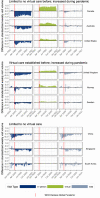Changes in primary care visits arising from the COVID-19 pandemic: an international comparative study by the International Consortium of Primary Care Big Data Researchers (INTRePID)
- PMID: 35534063
- PMCID: PMC9086267
- DOI: 10.1136/bmjopen-2021-059130
Changes in primary care visits arising from the COVID-19 pandemic: an international comparative study by the International Consortium of Primary Care Big Data Researchers (INTRePID)
Abstract
Introduction: Through the INTernational ConsoRtium of Primary Care BIg Data Researchers (INTRePID), we compared the pandemic impact on the volume of primary care visits and uptake of virtual care in Australia, Canada, China, Norway, Singapore, South Korea, Sweden, the UK and the USA.
Methods: Visit definitions were agreed on centrally, implemented locally across the various settings in INTRePID countries, and weekly visit counts were shared centrally for analysis. We evaluated the weekly rate of primary care physician visits during 2019 and 2020. Rate ratios (RRs) of total weekly visit volume and the proportion of weekly visits that were virtual in the pandemic period in 2020 compared with the same prepandemic period in 2019 were calculated.
Results: In 2019 and 2020, there were 80 889 386 primary care physician visits across INTRePID. During the pandemic, average weekly visit volume dropped in China, Singapore, South Korea, and the USA but was stable overall in Australia (RR 0.98 (95% CI 0.92 to 1.05, p=0.59)), Canada (RR 0.96 (95% CI 0.89 to 1.03, p=0.24)), Norway (RR 1.01 (95% CI 0.88 to 1.17, p=0.85)), Sweden (RR 0.91 (95% CI 0.79 to 1.06, p=0.22)) and the UK (RR 0.86 (95% CI 0.72 to 1.03, p=0.11)). In countries that had negligible virtual care prepandemic, the proportion of visits that were virtual were highest in Canada (77.0%) and Australia (41.8%). In Norway (RR 8.23 (95% CI 5.30 to 12.78, p<0.001), the UK (RR 2.36 (95% CI 2.24 to 2.50, p<0.001)) and Sweden (RR 1.33 (95% CI 1.17 to 1.50, p<0.001)) where virtual visits existed prepandemic, it increased significantly during the pandemic.
Conclusions: The drop in primary care in-person visits during the pandemic was a global phenomenon across INTRePID countries. In several countries, primary care shifted to virtual visits mitigating the drop in in-person visits.
Keywords: COVID-19; HEALTH SERVICES ADMINISTRATION & MANAGEMENT; PRIMARY CARE.
© Author(s) (or their employer(s)) 2022. Re-use permitted under CC BY-NC. No commercial re-use. See rights and permissions. Published by BMJ.
Conflict of interest statement
Competing interests: All authors have completed the ICMJE uniform disclosure form at www.icmje.org/coi_disclosure.pdf (available on request from the corresponding author) and declare the following: KT receives a Research Scholar award from the Department of Family and Community University of Toronto and research salary support from North York General Hospital, Toronto Western Family Health Team and the Rathlyn Foundation and has received grant funding from the Canadian Institutes of Health Research (CIHR), The College of Family Physicians of Canada/Foundation for Advancing Family Medicine/CMA Foundation, Heart and Stroke Foundation of Canada, Heart and Stroke Foundation of Ontario, Department of Defense United States of America, University of Toronto-Department of Family and Community Medicine), MaRS Innovation Fund, Canadian Dermatology Foundation, CRA (CIORA), PSI Foundation, Cancer Care Ontario, St. Michael’s Hospital Foundation, Toronto Rehab Institute Chair Fund, UTOPIAN, Arthritis Society, MS Society of Canada, The Canadian Vascular Network and Ontario SPOR Support Unit Targeted IMPACT Award. RSK teaches at the Swedish advanced training programme in quality improvement and owns stocks in the Swedish healthcare company Ambea. JG has received grant funding from NSERC and consulting fees from Verily Life Sciences. SdeL is the director of the Royal College of General Practitioners (RCGP) Research and Surveillance Centre (RSC) as part of his academic post at Oxford. He has received payment to his research group for health services and primary care research from the University of Oxford and the University of Surrey and a wide range of grant funding through his university for vaccine related research from AstraZeneca, GSK, Sanofi, Segirus and Takeda. WDP has received grant funding from NIMCH, sits on the advisory board of AT Still Research Foundation, has stock in Moderna and Pfizer and received supplies from TEVA. ES receives a CIHR postdoctoral fellowship award. No other authors have any other conflicts of interest to declare. All funding sources were not involved in the study design; in the collection, analysis, and interpretation of data; in the writing of the report; and the decision to submit the article for publication. The researchers are all independent from funders, and all authors had full access to all the data in the study and can take responsibility for the integrity of the data and the accuracy of the data analysis.
Figures
References
-
- World Health Organization . Coronavirus disease 2019 (COVID-19) situation report – 51, 2020. Available: https://www.who.int/docs/default-source/coronaviruse/situation-reports/2... [Accessed 11 April 2021].
-
- Roser M, Ritchie H, Ortiz-Ospina E, et al. . Coronavirus pandemic (COVID-19). Available: https://ourworldindata.org/coronavirus [Accessed 24 Feb 2022].
-
- World Health Organization . Primary health care. Available: https://www.who.int/news-room/fact-sheets/detail/primary-health-care [Accessed 27 Apr 2021].
Publication types
MeSH terms
LinkOut - more resources
Full Text Sources
Medical


